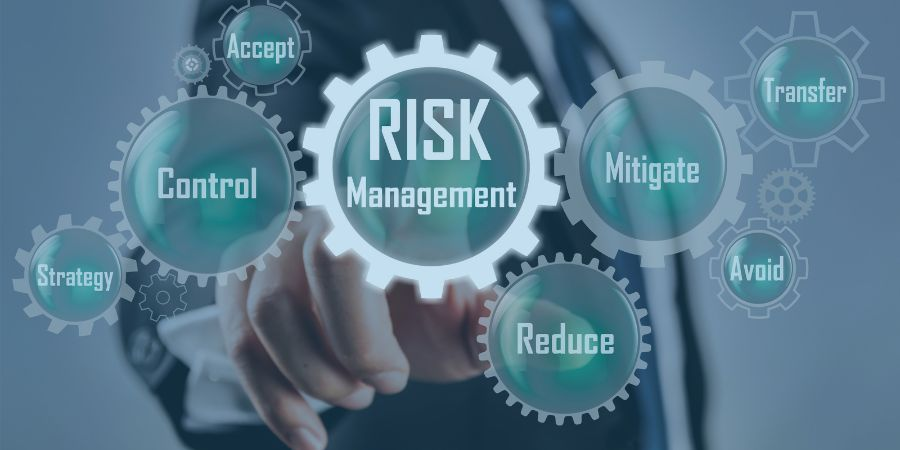Risk Treatment (With Examples)
Published on November 09, 2023
Last updated on May 22, 2025
Jump to a section
According to Investopedia, business risk is:
"the exposure a company or organisation has to factor(s) that will lower its profits or lead it to fail."
In terms of business management, risks may occur in the form of a challenge or threat that could affect a firm's performance according to a set strategy and its effectiveness in achieving the objectives.
If dealt with accurately, the risk might function as an opportunity to grow and expand the business. After all, successful companies take risks to succeed. However, when managed inappropriately, it might lead to severe consequences: from putting the company's information security in peril to endangering the firm's liability, to even legal repercussions. Thus, developing a solid risk management strategy is considered necessary for every aspiring company. It will ensure adequate response to the threats and make taking risks more profitable in the long run.

The successful strategy should include risk treatment and the assessment of possible consequences along with the needed input, calculation of costs and benefits, and a solution to deal with risks in the most strategic way. To understand this concept better, let's put it into context.
Different Types of Risks and Risk Levels
As risks are an inherent part of business management, they are bound to occur in every company and take many forms.
Firstly, we might distinguish risks emerging from different areas, such as business-related risks, economic risks, social risks, etc. The threats might take various forms, like an action (somebody making a mistake) or an event (like the global pandemic). Lastly, they may have both positive and negative impacts and lead to different outcomes.
Whether favourable or not, the expected outcome may be heavily dependent on the risk management strategy implemented. That's why it's crucial to develop proper risk management in the face of any threats and adequate risk treatment to take control over and deal with the risk in the best way possible in any given situation.

The inevitability of risks is also part of the reason why all organisations must conduct a risk assessment and risk analysis. Since risks exist and organisations acknowledge that it does, your goal here is to identify the risk level so that you can implement multiple controls and interim measures to manage the impact of those risks on your organisation. The data gathered during a risk assessment tells you the risk level of certain events and how you can address them. Not all risks are created equal so you need data to inform you of how to treat and manage them based on their potential impact.
Risk Treatment as a Part of Risk Management
Risk treatment is a collective term for all the tactics, options, and strategies chosen to respond to a specific risk, bound to achieve the desired outcome concerning the threat.
Consequently, risk treatment is not a concept functioning on its own. On the contrary, it should always be examined, understood, and implemented as part of a bigger whole; in other words, a full risk management strategy.

Simply put, the risk management process is a firm's policy, composed of different steps taken to ensure proper management of occurring threats. In general, risk management's actions include:
- Risk identification: The inspection process allows you to identify the organisation's potential risks to ensure all the threats are recognised.
- Risk assessment and evaluation: The analysis is bound to reveal the threat's consequences, outcome, likelihood, and severity. Thus, the analysis examines both the risk factor and the harm that it is bound to produce.
- Risk treatment: The plan of implementing various strategies, activities, and actions to appropriately deal with the threat and manage it in a possibly profitable way.
- Risk monitoring: The implementation of a continuous control system over the threat after treating it.
Notably, risk treatment should always go hand in hand with other processes enlisted in the company's risk management plan to ensure the alignment of the tactics with the firm's policy.
Five Steps of Risk Treatment
In the risk treatment process, it's recommended to follow five main steps to ensure the correct logistics and effectiveness of the strategy:
- Brainstorming and selecting the right risk treatment option.
- Planning and use of options chosen.
- Examining the effectiveness of the chosen tactics.
- Deciding whether the level of the remaining risk, i.e., residual risk, is acceptable or not.
- If it's not acceptable, implementing new risk treatment activities to reduce the residual risk.
Risk Treatment Options
There are several risk treatment strategies to deal with the risks. Notably, one kind of treatment cannot apply to all possible threats. It's crucial to review each threat individually to predict the effect of each solution.

Notably, the risk treatment options should be chosen based on a detailed analysis of the accompanying factors: the overall risk strategy of the company, its resources, the objectives of the organisation, as well as predicted costs against the benefits.
The risk treatment options include:
Risk Avoidance
If the risk assessment concludes that the risk is too high to be mitigated, it's possible to avoid the risk by resigning from performing specific actions or processes. The avoidance strategy is linked to interpreting the risk as unfavourable to the point that it should be excluded entirely. To avoid the risk, the company might choose to perform another action instead, as the alternative generates a lower threat.
Examples of risk avoidance as part of the risk treatment strategy is to change your processes, equipment, or materials. Treating risks through avoidance is a step that should only be taken if you have determined that the impact and risk level are so high that it could jeopardise the entire organisation. Dealing with a high-risk level is not worth the risk, even if it means sacrificing some opportunities in the process.

For example, suppose the launch of a new product line is identified as high-risk, and the impact of the expected cost is deemed as not acceptable. In that case, the product line will be exited and replaced with the one expected not to generate a threat.
Risk Reduction
Risk reduction is an important risk treatment strategy because it requires taking action to reduce the impact of a given risk while maximising the benefits obtained from taking such action(s).
To reduce the likelihood of risk or to bring its consequences down to an acceptable level, the company might implement safeguards or controls, carefully chosen from the range of available control processes. By diminishing the risk to the required level, this option ensures the needed level of security.
The controls might occur in different forms, such as fire-suppression systems, joint application design, or best practices in employee training. It's essential to ensure that all tactics are bound to reduce risk to a sufficient level to continue doing business.
When risk controls reduce the risks, it is possible to examine the residual risk, i.e. the threat remaining after implementing the loss reduction treatment.

There are two steps to reduce risk as part of the risk treatment plan. The first one is using preventive methods, such as:
- Human resources and staff training
- Legislation compliance
- Quality control measures
- Auditing
- Regular maintenance
- Security systems installation
The second method to reduce risk involves the implementation of certain procedures upon the occurrence of a risk event:
- Data backups
- Emergency procedures
- Minimise exposure to highest-rated risks
Risk Transfer
Transferring risk is related to passing a specific portion of the threat to another party to reduce its likelihood or impact on the organisation. However, it's vital that another party - for example, an insurance company - is informed about the consequences of the sharing, the impact of the risk, and the expected transfer cost.
This type of risk treatment might be executed by signing a contract with a service provider or purchasing an error insurance.
Notably, this option does not mitigate the risk itself, as it deals only with its consequence. Thus, the transfer treatment should be typically implemented along with other risk treatment plans.

There are various forms of implementing this particular risk treatment option, such as the following:
- Hedging strategies
- Contractual agreements
- Hiring a security company
- Properly vetting suppliers and vendors
Risk Retention
Suppose the analysis concludes that the risk rating is at acceptable levels, or the mitigation cost of the implemented strategy is higher than the expected damage. Only after the cost-benefit analysis is performed should you decide to choose risk retention as your best risk treatment option.
In that case, the appropriate treatment might be to accept the risk and not take any actions to treat it. However, you must only choose this treatment option assuming the risk should always go hand in hand with implementing a system that would continuously control and monitor the given risk, along with its possible development.
What is a Risk Treatment Plan?
It's recommended to create a Risk Treatment Plan to avoid confusion in planning treatment activities. A Risk Treatment Plan is a document in which the company's policy regarding risk treatment is outlined in detail. The outline should contain information about the parties responsible for implementing each control option, the date and the timeframe, the available budget, etc. The detailed form will ensure a clear and unified strategy that will be easier to follow.
Familiarise Yourself with ISO/IEC 27005
More specific information regarding risk management processes, available treatment plans, and correct responses to possible threats can be found in the risk management standard ISO/IEC 27005.

This set of standards developed by the International Organisation for Standardisation (ISO) and the International Electrotechnical Commission (IEC) provides guidelines for ensuring information security and recommended processes and models concerning risk management. It is also applicable to all kinds of businesses that wish to develop concrete strategies and gain knowledge on risk management.
The bottom line on risk treatment
Risks are an inherent part of any business, and each company is bound to face them multiple times at every stage of its development. That's why adequate risk management policies need to be implemented while planning the overall management plan.To ensure fast and adequate action in the face of a threat, it's crucial to regularly do a thorough analysis of the risk strategy and keep improving the risk management plan, including risk identification, risk assessment, risk treatment, and risk monitoring. Preferably, the appropriate treatment plan should be created, whose implementation could ensure each treatment activity responds to specific risk types.
When choosing the adequate risk treatment, it's important to remember to review the company's available resources and ensure the project's alignment with good policies as defined by ISO. Only a thorough understanding and correct implementation of all those factors will provide correct risk responses and, consequently, constitute the firm's success.
FAQs on Risk Treatment

What is risk assessment?
Risk assessment is the systematic process of potential risk identification for a business entity or a potential activity. Risk identification is just the first step of the process because there are other steps within the risk treatment process, such as risk avoidance and risk reduction.
It could also involve taking measures to modify the risk and reduce its potential impact on the organisation.
What is risk treatment example?
Of course, it's helpful to understand what a risk treatment actually is. Really, it's nothing more than an action taken to help manage or mitigate risks. A very general example would be installing fire alarms to mitigate the risk of fire within an office or installing fire suppression systems in a warehouse.
What is the importance of risk treatment?
The goal of risk treatment is to remove, reduce, or redirect residual risk. Developing risk treatment plans is an integral part of protecting the business by making sure that risk does not take into action instead of dealing with it. Effective risk treatment relies on identifying the different types of risk against that particular business entity.
What is included in a risk treatment plan?
A risk treatment plan must consist of the primary and secondary risks, the risk mitigation strategies, and the actionable steps to take with the risk occurring. It is important that your risk treatment plan should also include a target date to create a sense of urgency in dealing with the risks identified.
What are the risk treatment and action plan?
The risk treatment plan is the step of identifying risks and determining what action to take against the identified risks. On the other hand, the action plan is when you identify the steps you must take in treating risks and reducing their impact. Set realistic objectives for your risk treatment plan to ensure that you have the right resources to treat risks.
What is the most effective risk treatment strategy?
All of the above risk treatment strategies have their benefits and drawbacks. The answer is that it depends on the types of risk that you are dealing with as an organisation and the associated risk levels. A cost-benefit analysis is vital in picking the right strategy, whether you choose to avoid or accept the risk to your organisation. The key stakeholders must be involved in choosing the best treatment option for your organisation, as well as in developing realistic objectives to match your risk assessment process.
Which is not an example of a risk management strategy?
- Ignoring the risk: Choosing to do nothing about a known risk and not including it in any planning or mitigation efforts.
- Speculation: Engaging in actions that increase exposure to risk in hopes of achieving higher gains without any plan to manage potential losses.
- Inaction due to indecision: Delaying decision-making in the face of identified risks, which can lead to increased vulnerability and potential losses.
- Lack of risk assessment: Failing to perform a risk assessment to understand the potential impacts and likelihood of risks occurring.
These actions do not align with the proactive and systematic approach of risk management, which involves identifying, assessing, and responding to risks to minimise their impact on organisational objectives. Risk management strategies are designed to address risks deliberately and methodically, rather than ignoring them or leaving them to chance.
C2 Meridian is a web-based tool that allows you to manage your business' Operational Resilience & Business Continuity Management System on a day-to-day basis. Learn more about our Business Continuity Management Software today and find out how we can help your business thrive even in times of disruption.
Written by Richard McGlave
Founder & CEO at Continuity2
With over 30 years of experience as a Business Continuity and Resilience Practitioner, Richard knows the discipline like the back of his hand, and even helped standardise BS25999 and ISO 22301. Richard also specialises in the lean implementation of Business Continuity, IT Service Continuity and Security Management Systems for over 70 organisations worldwide.


Written by Richard McGlave
Founder & CEO at Continuity2
With over 30 years of experience as a Business Continuity and Resilience Practitioner, Richard knows the discipline like the back of his hand, and even helped standardise BS25999 and ISO 22301. Richard also specialises in the lean implementation of Business Continuity, IT Service Continuity and Security Management Systems for over 70 organisations worldwide.